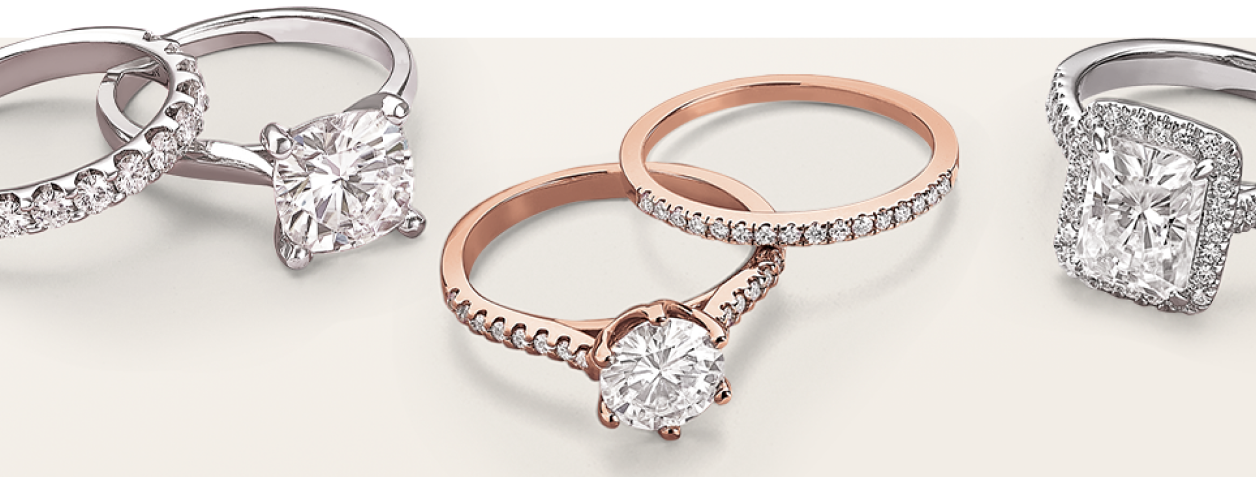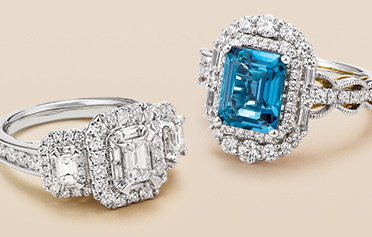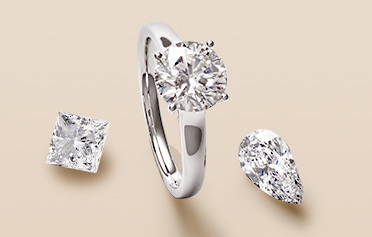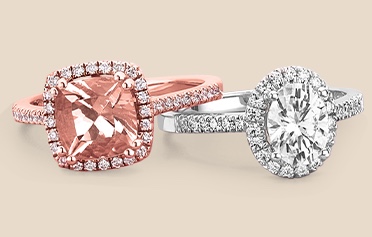Diamond vs. Moissanite
If you're searching for a beautiful and valued alternative to natural diamonds, lab-created moissanite should have your attention. These dramatic gems offer incredible shine and fire in a variety of shapes, making them a gorgeous, long-lasting option for your engagement ring or other jewelry. Here's a look at moissanite vs. diamonds side by side:

benefits of moissanite
Moissanite is a durable, brilliant gem that offers eye-catching fire at an affordable price. A mineral form of crystalline silicon carbide, moissanite takes its name from Henri Moissan, the scientist who discovered the gem in the late 19th century. Because natural moissanite is so rare, the gems must be created in a lab.
Giving off a breathtaking rainbow flash in natural lighting, these lab created gems put an unconventional twist on the traditional diamond engagement ring. They also look extraordinary in earrings and pendants. Because moissanites will never lose their exceptional sparkle, they can become meaningful heirloom jewelry.
differences between moissanite vs. diamond stones
While moissanite gems and natural diamonds are
both popular in the jewelry world, they differ in many important ways. From brilliance and durability to color and
price, it's important to get an idea of these differences before you choose a stone
durability
All gemstones are measured on the Mohs
Scale of Hardness to grade their ability to withstand surface scratching. On the Mohs Scale, natural
diamonds receive a 10, while moissanites score a 9.25. Each of these scores is very high, making both
stones
great options
brilliance
Moissanite gems have a unique faceting
pattern that delivers fiery, rainbow flashes. Moissanites also have a refractive index of around
2.65–2.69, which is higher than natural diamonds. That said, a natural diamond is able to reflect
light in more complex ways, via brilliance, scintillation and dispersion. This combination is what gives
diamonds their one-of-a-kind
color
Natural diamonds can range in color
from
colorless to faint, based off of international grading standards (D–Z). Though moissanites are not
graded on the same scale, they may also be colorless, near-colorless, or have faint grayish or
slight-yellowish hues. In most instances, the larger the moissanite gem, the more noticeable its color.
Helzberg Diamonds only offers moissanite in the near-colorless
price
A diamond's price is determined by the
all-important 4Cs (cut,
clarity,
color and carat). A lab created moissanite's price is determined by size, color and clarity.
Moissanite can cost about four to five times less than a natural diamond of the same size and similar
quality. This makes moissanite a popular choice among people in search of affordable jewelry that still
delivers heirloom-quality
sourcing
Natural diamonds, which are composed of bonded carbon atoms that have crystallized, are formed over billions of years beneath the earth. They are then expertly mined and sourced through the Kimberly Process, resulting in a one-of-a-kind diamond. Made from the mineral silicon carbide, moissanite gems are created in dedicated facilities, making them an appealing option for people seeking gemstones that don't require mining. Lab grown diamonds are also popular lab-created stones with the unmistakable fire and brilliance of natural diamonds.
frequently asked questions
No. While they have a smiliar look, moissanite derives from the mineral silicon carbide, wheras diamonds are composed of crystalized bonded carbon atoms.
While both mined and lab-grown diamonds are graded on the 4C's, moissanite is only graded on color, and it is not given a single letter grade. They are typically graded according to a range of color: D-E-F (colorless), G-H-I (near-colorless) and J-K (faint color).
In a nutshell, lab grown diamonds take mining out of the equation by replicating the heat and pressure required to form a diamond in a lab. Both natural and lab grown diamonds are structurally and visually identical; plus they both score a 10 on the Mohs Scale of Hardness.
In 1893, Nobel Prize-winning chemist Dr. Henri Moissan discovered moissanite in a meteorite crater. In the earth, this unique gem is formed from the mineral silicon carbide. Through heat and pressure, the naturally occurring process is duplicated to produce lab created moissanite gems that are so brilliant, only experts can tell the difference between them and natural moissanite.
schedule an appointment
Schedule an online or in-person appointment to discuss the different types of gemstones Helzberg carries and explore our gemstone jewelry selection.
Schedule nowMore advice

engagement buying guide
Finding the perfect engagement ring can be overwhelming, but it doesn't have to be.
Learn more
all about moissanite
A stone with major sparkle all its own, moissanite is a popular diamond alternative.
Learn more
natural vs. lab grown diamonds
Learn the difference between diamonds mined from the earth and diamonds grown above ground.
Learn more














